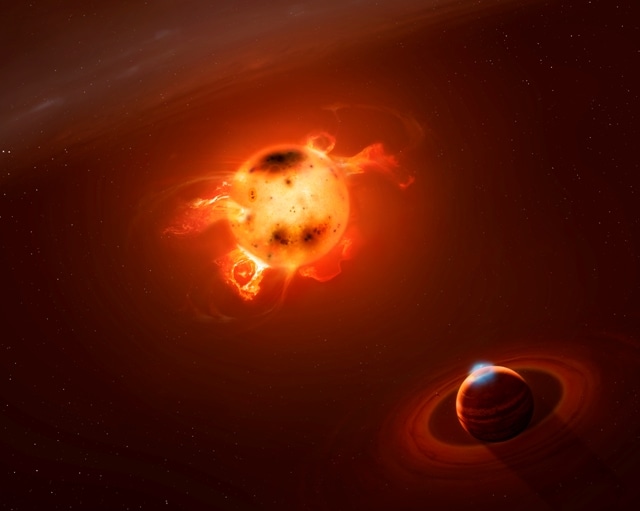Jun 23 2016
Exoplanets referred to as 'hot Jupiters' have mystified astronomers for the past two decades. These giant planets have increased surface temperatures as they orbit 100 times nearer to their host stars than Jupiter does to the Sun. The question is how and when they shifted so close to their star.
 Artist’s impression of a young giant planet in the immediate vicinity of a star in formation. (Credit- Mark Garlick / markgarlick.com)
Artist’s impression of a young giant planet in the immediate vicinity of a star in formation. (Credit- Mark Garlick / markgarlick.com)
Recently, an international group of astronomers discovered a very young hot Jupiter orbiting in the immediate surroundings of a star that is barely two million years old (stellar equivalent of a week-old infant). This is the first evidence that hot Jupiters can appear at such an early stage and it is a major step in understanding how planetary systems are formed and evolved. The research, led by scientists at the Institut de Recherche en Astrophysique et Planétologie (IRAP, CNRS/Université Toulouse III – Paul Sabatier), in association with co-workers at the Institut de Planétologie et d'Astrophysique de Grenoble (CNRS/Université Grenoble Alpes), is reported in the June 20th, 2016, issue of the journal Nature.
An international group of astronomers found the youngest hot Jupiter while examining a star that was barely two million years old, known as V830 Tau, located in the Taurus stellar nursery 430 light years away. The group examined the star for one and a half months, and identified a standard fluctuation in the star’s velocity, indicating the presence of a planet as huge as Jupiter, orbiting its host star at a distance only one twentieth of that between the Earth and the Sun. This finding proves that hot Jupiters can appear at an initial stage in the development of planetary systems, and therefore have a significant effect on their architecture.
Small rocky planets like Earth, orbit close to the Sun in the solar system, whereas gas giants such as Saturn and Jupiter are located further outside. Astronomers were surprised when the first exoplanets identified were giants orbiting near their host star. Theoretical work proves that these planets can only form in the icy outer areas of the protoplanetary disk in which the central star and their adjacent planets are born. Some of them move inwards while avoiding falling into their host star, becoming hot Jupiters.
According to the theoretical models, migration takes place either early in the lives of giant planets while still being implanted in the protoplanetary disk, or later, once many planets are created and interact, bringing a few of them into the immediate surroundings of their star. Some of the hot Jupiters are tilted or orbit backward, indicating that they were flung near their star by adjacent bodies. The finding of a very young hot Jupiter proves that initial migration within the disk is also applicable to huge planets.
Identifying planets in orbit surrounding extremely young stars is a vital observational challenge; as such stars are monsters when compared to the Sun. This is due to their strong magnetic activity interfering with the light emitted by the star to a much larger extent than a potential huge planet, in a close orbit too. Separation of the signal due to the activity of the star from the planet’s signal is one among the team’s numerous achievements.
The research group used twin spectropolarimeters- Narval and ESPaDOnS, designed and developed at IRAP for this study. ESPaDOnS is placed on the Canada-France-Hawaii Telescope (CFHT) on the top of Maunakea, a dormant volcano on the Island of Hawaii. Narval is mounted on the Bernard Lyot telescope (TBL - OMP) on top of the Pic du Midi in the French Pyrenees. The collective usage of these two telescopes along with Hawaii's Gemini telescope was necessary for the continuous examining of V830 Tau. SPIP and SPIRou are the next-generation infrared spectropolarimeters built at IRAP for the TBL and CFHT. SPIP and SPIRou are scheduled for first light in 2017 and 2019 respectively. This would result in enhanced superior performance and render it possible to examine the creation of new worlds with unparalleled sensitivity.